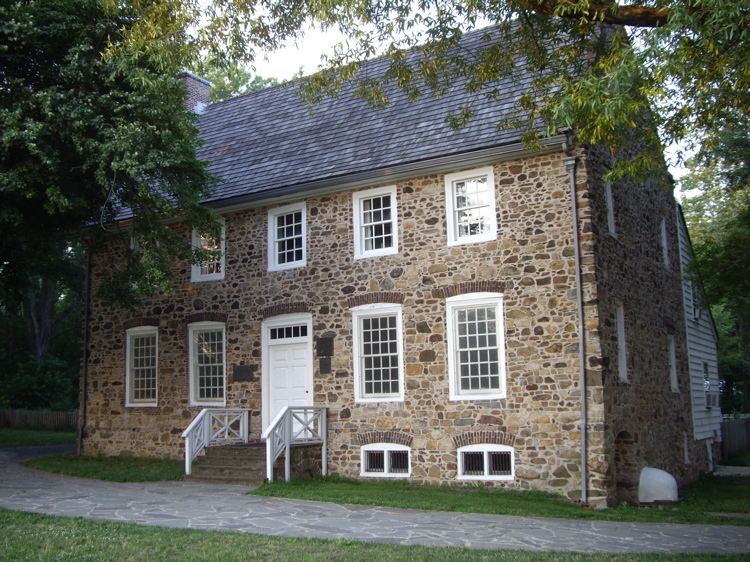Built circa 1675 Designated NHL May 23, 1966 Phone +1 718-984-6046 | NRHP Reference # 66000566 Area 1 ha Added to NRHP 15 October 1966 | |
 | ||
Location Address 7455 Hylan Blvd, Staten Island, NY 10307, USA Hours Open today · 1–4PMSaturday1–4PMSunday1–4PMMondayClosedTuesdayClosedWednesdayClosedThursdayClosedFriday1–4PM Architectural styles Dutch Colonial Revival architecture, American Colonial Similar Conference House Park, Historic Richmond Town, Garibaldi‑Meucci Museum, Alice Austen House, Sailors' Snug Harbor Profiles | ||
The Conference House (also known as "Billop House") was built before 1680 and is located near the southernmost tip of New York State on Staten Island, which became known as "Billop's Point" in the 18th century. The Staten Island Peace Conference was held here on September 11, 1776, which unsuccessfully attempted to end the American Revolutionary War. The house, a National and New York City Landmark, is the only pre-Revolutionary manor house still surviving in New York City. It is located at Conference House Park overlooking Raritan Bay. The house is also located within the Ward's Point Conservation Area, separately added to the National Register of Historic Places in 1982.
Contents
- The conference house on staten island new york
- Before the American Revolution
- Peace Conference
- Billops Point
- Notable Visitors
- Units Camped at Bentley Manor
- Conservation
- References
The conference house on staten island new york
Before the American Revolution
Captain Christopher Billopp, after years of distinguished service in the Royal Navy, came to America in 1674. He was granted a land patent on 932 acres (3.7 km²) on the southernmost tip of Staten Island. Archaeological evidence, including shell middens and digs conducted by The American Museum of Natural History in 1895, have shown that the Raritan band of the Lenape camped in the area and used the location as a burial ground. The burial ground known as Burial Ridge is the largest pre-European burial ground in New York City.
As the legend goes, Capt. Billopp's seamanship secured Staten Island to New York, rather than to New Jersey: the island would belong to New York if the captain could circumnavigate it in one day – which he proceeded to do.
In 1677, the fortunes of colonial service took Capt. Billopp to New Castle on the Delaware River, where he commanded the local garrison. Upon appointment of Thomas Dongan as governor of the colony of New York, he returned to Staten Island and became active in the local government. He was further rewarded by another patent, expanding his Staten Island property to 1,600 acres (6.4 km²).
It is difficult to ascertain exactly when his manor house was built, but one surviving map shows that a building existed on the site of the Conference House before 1680. The house was passed down to his great grandson Christopher Billop, who was commissioned a colonel and led loyalist forces against the patriots in the American Revolution. After the cessation of hostilities and British withdrawal from the former colonies, the house was confiscated by the state of New York with no recompense to the Billopp family.
Peace Conference
On September 11, 1776, Lord Howe, commander in chief of British forces in America, arranged to meet with representatives of the Continental Congress in a peace conference aimed at halting the American Revolution. Benjamin Franklin, John Adams, and Edward Rutledge rowed over from patriot-held Perth Amboy, New Jersey. The meeting lasted for three hours and ended with the Americans politely declining Howe's offer, leading to another seven years of conflict.
Billop's Point
The Conference House is situated on the southernmost point of New York State; this point of land, jutting out into Raritan Bay, was known as "Billop's Point" during the 18th century. It was from Billop's Point that a raid on October 25, 1779, known as "Simcoe's Raid", was conducted upon patriot-held New Jersey by John Graves Simcoe, leader of the Tory unit the Queen's Rangers. In A History Of The Operations Of A Partisan Corps Called The Queen's Rangers, which he wrote after the war, he mentions:
The batteaux, and boats, which were appointed to be at Billop's-point, so as to pass the whole over by twelve o'clock at night, did not arrive till three o'clock in the morning.
Billop's point is mentioned in the journal of Major André:
Oct. 25th The Regiments at Amboy received Orders to strike their tents and send them with their baggage to the water's side. Those at Staten Island had orders to leave theirs standing, and repair by 8 o'clock in the evening to Billop's Point.
Notable Visitors
Units Camped at Bentley Manor
Conservation
One hundred years after the conference, the house was abandoned and vandalized. After the revolution, most of the Billopps had gone to Canada. In 1901 Assemblyman Van Name of Richmond County, New York introduced a bill for the preservation of the house. In 1926 the house was in danger of being razed. Through the efforts of a group of concerned citizens, a non-profit organization, "The Conference House Association", was formed, and the house was saved. In 1929 the Municipal Assembly of the City of New York placed the house under the association's aegis. The Conference House Park was created in 1926.
The house was declared a National Historic Landmark in 1966.
